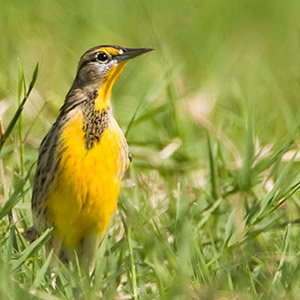Prairie birds have retinas configured to look upwards
12-03-2013

Birds use mainly vision to look at their surroundings in search of food, mates and predators. Their retinas have centers of acute vision that are oriented towards important areas in their environment. Previous research has shown that these retinal centers of acute vision were directed towards the ground (e.g., pigeons) or the horizon (e.g., ducks). However, a recent study published in Scientific Reports (http://www.nature.com/srep/) by doctoral student Luke Tyrrell (who is in Dr. Fernández-Juricic's lab) shows that the center of acute vision in Eastern meadowlarks, which inhabit open grasslands, projects into the sky. The visual system of meadowlarks appears specialized for detecting and tracking aerial predators as well as territory intruders.
Tyrrell, L.P., B.A. Moore, C. Loftis & Esteban Fernandez-Juricic. 2013. Looking above the prairie: localized and upward acute vision in a native grassland bird. Scientific Reports 3, Article number: 3231
Photo: © Ncbateman1 | Dreamstime Stock Photos & Stock Free Images